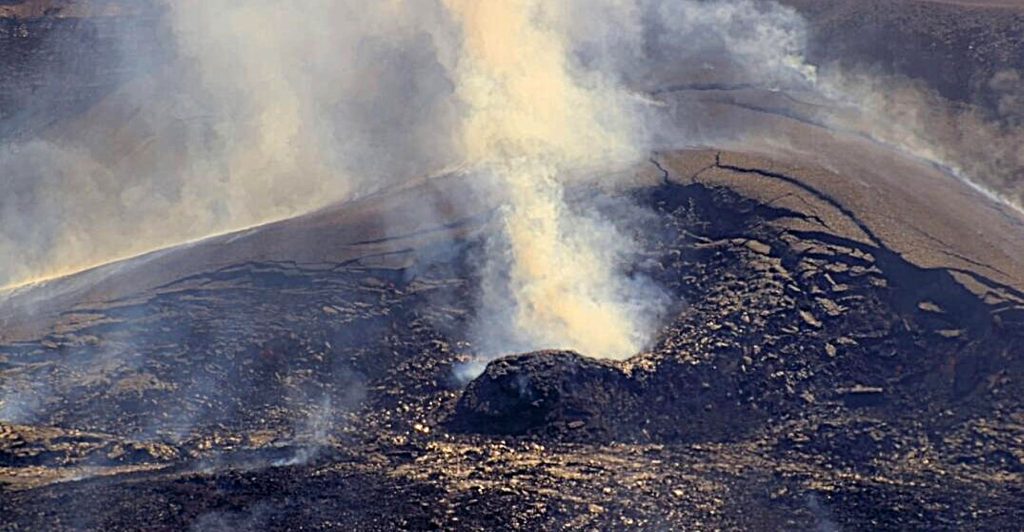UPDATE: Episode 28 was great, showing off with 1,200-foot molten rock geysers
Update at 3:37 p.m. July 9, 2025: Episode 28 of the ongoing episodic summit eruption of the Big Island’s Kīlauea volcano showed off a little, pumping molten rock geysers up to heights of about 1,200 feet from the north vent inside its Halemaʻumaʻu Crater.
But as has been the case for the past several eruptive episodes, it didn’t last too long.
Episode 28 was great, firing off high lava fountains for 8 of the continous 9 hours of fountaining from 4:10 a.m. until ending abruptly at 1:20 p.m. today.

There did not appear to be any activity from the south vent at all during this episode, and it was completely covered by new deposits. The growing cone around the north vent also started to connect with the top of the surrounding cliff in some places.
Lava flows from this episode onto the floor of Halemaʻumaʻu within the southern part of Kaluapele, the summit caldera of Kīlauea, might continue to exhibit slow movement or incandescence as they cool and solidify during the coming days.
Slumping of molten cone material around the north vent could also continue for the next 24 hours and can produce small, localized lava flows.
Volcanic gas emissions greatly decreased since the end of fountaining.
The Uēkahuna tiltmeter at the summit recorded about 15 microradians of deflation during Episode 28.
The end of the eruptive activity coincided with a rapid change from deflation to inflation at the summit and decrease in seismic tremor intensity, as has been the case with each previous episode during this ongoing summit eruption that began Dec. 23, 2024, .
Most episodes of have continued for about a day or less and have been separated by pauses in activity of at least several days.
No changes have been detected in the East Rift Zone or Southwest Rift Zone. HVO continues to closely monitor Kīlauea.
Hazards still exist, including Pele’s hair and tephra, which could affect areas downwind of the eruptive vents, as well as vog, or volcanic smog. Visit the Hawaiian Volcano Observatory website for additional information.
Kīlauea’s U.S. Geological Survey Volcano Alert Level remains at Watch and its Aviation Color Code at Orange.
All current and recent eruptive activity is within Hawaiʻi Volcanoes National Park. Visit the park website for up-to-date visitor information.
Hawaiian Volcano Observatory continues to closely monitor Kīlauea. A new Volcanic Activity Notice will be issued at the start of the next eruptive episode.
Regularly scheduled daily Kīlauea updates are posted on the observatory website.
You also can keep a keen eye on the eruptive vents inside Halemaʻumaʻu Crater yourself by checking out the three Kīlauea summit livestreams available on YouTube.
Original story posted at 7:43 a.m. July 9, 2025: Kīlauea is putting on a show once again.
Episode 28 of the ongoing Halemaʻumaʻu eruption began at 4:10 a.m., and is currently exhibiting a vent overflow and fountains reaching roughly 150 feet, according to U.S. Geological Survey this morning.
All eruptive activity is confined to Halemaʻumaʻu crater within Hawaiʻi Volcanoes National Park. No changes have been detected in the East Rift Zone or Southwest Rift Zone.
The Hawaiian Volcano Observatory’s watch status for Kīlauea volcano remains in effect. According to Hawai‘i County Civil Defense Agency, tephra from the eruption is falling on Highway 11 between the 36 and 40 mile markers. Motorists are advised to drive with caution.
The National Weather Service also issued an alert warning of periods of ashfall from the eruption.
Web cams and satellite data indicate that occasional small bursts of volcanic ash continue to emanate from Halema‘uma‘u Crater. Low-level trade winds will push ash toward the west to west-southwest, and any ash fallout will likely occur over the Ka‘ū District and Highway 11 southwest of the town of Volcano.
The county agency also advises motorists to expect slow-moving traffic and traffic congestion in and around the national park.
Most episodes of Halemaʻumaʻu lava fountaining since Dec. 23, 2024, have continued for around a day or less and have been separated by pauses in eruptive activity lasting generally at least several days.
Past eruptive episodes have produced incandescent lava fountains over 1,000 feet high that result in eruptive plumes up to 20,000 feet above ground level, according to USGS.
High fountaining associated with this episode has not yet begun but is expected to start soon, as tremor, deflation, and fountain height are all increasing.
Three Kīlauea summit livestream videos that show eruptive lava fountains are available here: https://www.youtube.com/@usgs/streams
Episode 28 was preceded by gas pistoning cycles, some of which produced small lava overflows at the north vent yesterday. Fountains from the north vent are currently 150 feet high and feeding multiple lava streams at 5 a.m.
Click here for the timeline of eruptive episodes since December. 23, 2024.











